
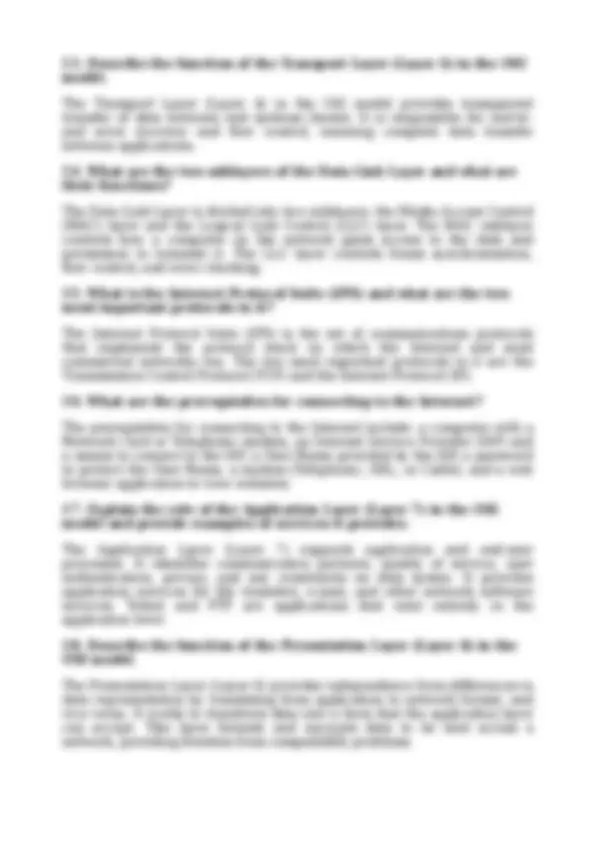
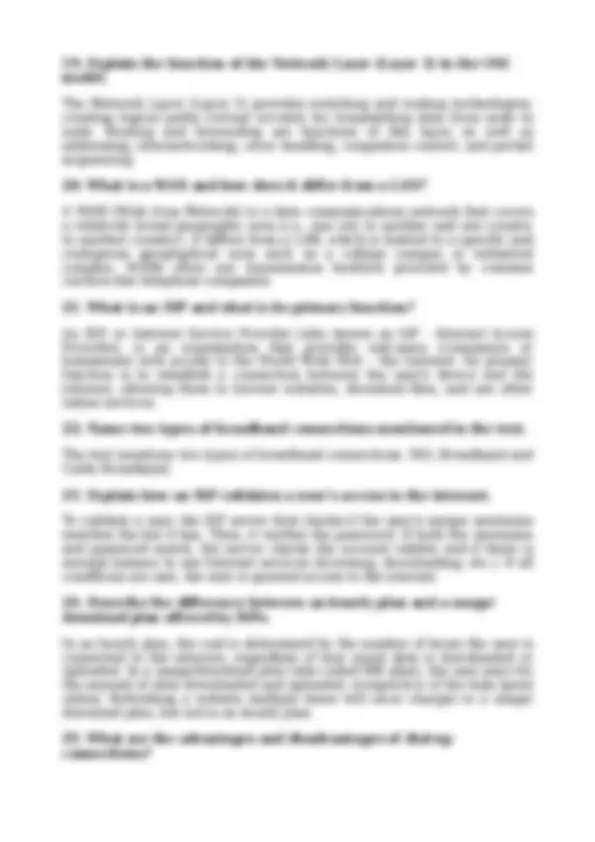
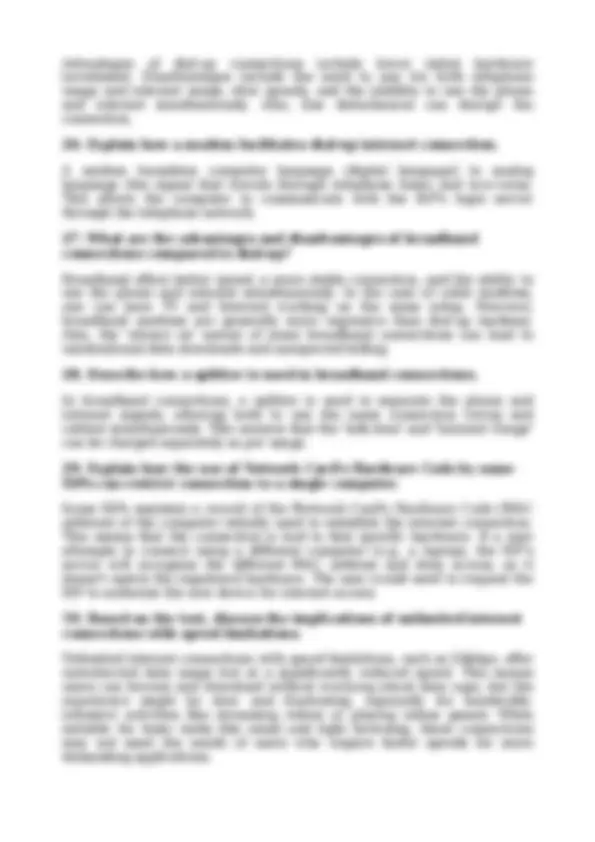
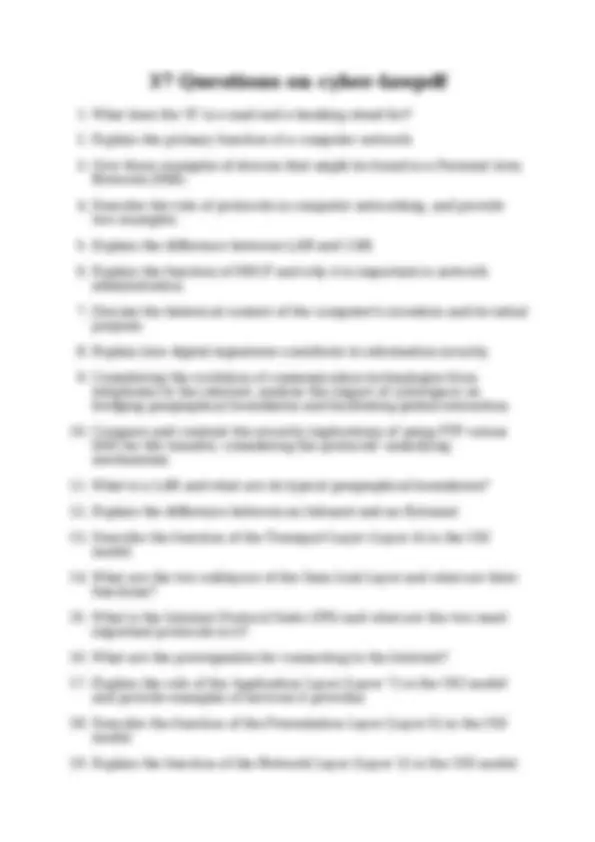
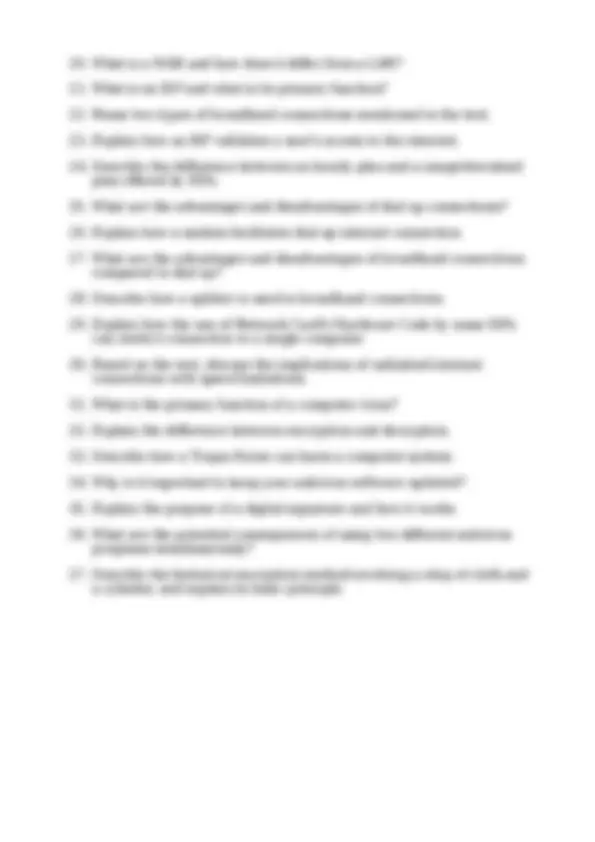


Study with the several resources on Docsity

Earn points by helping other students or get them with a premium plan


Prepare for your exams
Study with the several resources on Docsity

Earn points to download
Earn points by helping other students or get them with a premium plan
Community
Ask the community for help and clear up your study doubts
Discover the best universities in your country according to Docsity users
Free resources
Download our free guides on studying techniques, anxiety management strategies, and thesis advice from Docsity tutors
An overview of the cyber world, focusing on the internet, online resources, information security, and digital signatures. It explains the scope of computers in daily life, fundamental computer principles, and the basics of computer networks. It covers internet connection prerequisites, isp operations, dial-up and broadband connections, and various internet applications. The document also addresses information security, types of threats, prevention measures, and the use of digital signatures to secure documents in cyberspace. It is designed to provide a foundational understanding of computer networks and online security for students and professionals alike, offering insights into both the technical and practical aspects of navigating the digital world. Useful for those seeking to understand the basics of computer networking and security.
Typology: Exercises
1 / 9

This page cannot be seen from the preview
Don't miss anything!






You'll find the list of questions at the end of the document
1. What does the 'E' in e-mail and e-banking stand for?
The 'E' in e-mail and e-banking stands for 'Electronic'. It signifies that these activities are conducted using electronic means.
2. Explain the primary function of a computer network.
The primary function of a computer network is to enable communication and sharing of resources (knowledge or information, hardware equipment, software etc.) between two or more computers.
3. Give three examples of devices that might be found in a Personal Area Network (PAN).
Examples of devices that may be used in a PAN are printers, fax machines, and telephones.
4. Describe the role of protocols in computer networking, and provide two examples.
Protocols are a set of rules or standards that govern the connection, communication, and data transfer between two computing endpoints. They ensure that different devices can communicate effectively. Examples include TCP (Transmission Control Protocol) and HTTP (Hypertext Transfer Protocol).
5. Explain the difference between LAN and CAN.
A LAN (Local Area Network) covers a small geographic area, like a home, office, or building. A CAN (Campus Area Network) connects two or more LANs across a limited geographical area, such as a university campus or a business park.
6. Explain the function of DHCP and why it is important in network administration.
DHCP (Dynamic Host Configuration Protocol) is a protocol used by networked devices to obtain IP addresses and other parameters (like default gateway, subnet mask, and DNS server addresses) from a DHCP server. It's important because the DHCP server ensures that all IP addresses are unique, simplifying IP address pool management and reducing the administrative burden on network administrators.
7. Discuss the historical context of the computer's invention and its initial purpose.
The computers were invention of Cold Wars. In beginning, they are humongous, very large in size, would cover a size of a football ground, and may be bigger.
8. Explain how digital signatures contribute to information security.
Digital signatures are used to verify the authenticity and integrity of digital documents or messages. They provide assurance that the message was sent by the claimed sender and that the content has not been altered in transit. This is achieved through cryptographic techniques that bind the sender's identity to the message in a way that is difficult to forge.
9. Considering the evolution of communication technologies from telephones to the internet, analyze the impact of cyberspace on bridging geographical boundaries and facilitating global interaction.
Telephones allowed voice communication, but were limited to point-to-point connections. The internet, and cyberspace in general, revolutionized communication by enabling multifaceted interactions (text, voice, video) across vast distances, irrespective of physical boundaries. This has fostered global collaboration, information sharing, and economic integration on an unprecedented scale, effectively shrinking the world and creating a virtual space for interaction.
10. Compare and contrast the security implications of using FTP versus SSH for file transfer, considering the protocols' underlying mechanisms.
FTP (File Transfer Protocol) transmits data, including usernames and passwords, in plain text, making it vulnerable to eavesdropping and interception. SSH (Secure Shell), on the other hand, encrypts all data transmitted, including authentication credentials, providing a secure channel for file transfer. Therefore, SSH is significantly more secure than FTP, especially when transferring sensitive information over untrusted networks. The use of public-key cryptography in SSH further enhances security by allowing for secure authentication and key exchange.
11. What is a LAN and what are its typical geographical boundaries?
A LAN (Local Area Network) is a network that connects computers within a limited and contiguous geographical area. This area is typically a college campus, industrial complex, or a military base.
12. Explain the difference between an Intranet and an Extranet.
An Intranet is a network that uses Internet Protocol (IP) and IP-based tools, controlled by a single administrative entity, like an office network where users share resources. An Extranet is an Intranet with limited connections to other networks, such as a company granting limited access to its Intranet to external partners, but the connection is not fully trusted from a security perspective.
19. Explain the function of the Network Layer (Layer 3) in the OSI model.
The Network Layer (Layer 3) provides switching and routing technologies, creating logical paths (virtual circuits) for transmitting data from node to node. Routing and forwarding are functions of this layer, as well as addressing, internetworking, error handling, congestion control, and packet sequencing.
20. What is a WAN and how does it differ from a LAN?
A WAN (Wide Area Network) is a data communications network that covers a relatively broad geographic area (i.e., one city to another and one country to another country). It differs from a LAN, which is limited to a specific and contiguous geographical area such as a college campus or industrial complex. WANs often use transmission facilities provided by common carriers like telephone companies.
21. What is an ISP and what is its primary function?
An ISP, or Internet Service Provider (also known as IAP - Internet Access Provider), is an organization that provides end-users (consumers or businesses) with access to the World Wide Web – the Internet. Its primary function is to establish a connection between the user's device and the internet, allowing them to browse websites, download files, and use other online services.
22. Name two types of broadband connections mentioned in the text.
The text mentions two types of broadband connections: DSL Broadband and Cable Broadband.
23. Explain how an ISP validates a user's access to the internet.
To validate a user, the ISP server first checks if the user's unique username matches the list it has. Then, it verifies the password. If both the username and password match, the server checks the account validity and if there is enough balance to use Internet services (browsing, downloading, etc.). If all conditions are met, the user is granted access to the internet.
24. Describe the difference between an hourly plan and a usage/ download plan offered by ISPs.
In an hourly plan, the cost is determined by the number of hours the user is connected to the internet, regardless of how much data is downloaded or uploaded. In a usage/download plan (also called MB plan), the user pays for the amount of data downloaded and uploaded, irrespective of the time spent online. Refreshing a website multiple times will incur charges in a usage/ download plan, but not in an hourly plan.
25. What are the advantages and disadvantages of dial-up connections?
Advantages of dial-up connections include lower initial hardware investment. Disadvantages include the need to pay for both telephone usage and internet usage, slow speeds, and the inability to use the phone and internet simultaneously. Also, line disturbances can disrupt the connection.
26. Explain how a modem facilitates dial-up internet connection.
A modem translates computer language (digital language) to analog language (the signal that travels through telephone lines) and vice-versa. This allows the computer to communicate with the ISP's login server through the telephone network.
27. What are the advantages and disadvantages of broadband connections compared to dial-up?
Broadband offers better speed, a more stable connection, and the ability to use the phone and internet simultaneously. In the case of cable modems, one can have TV and Internet working on the same setup. However, broadband modems are generally more expensive than dial-up modems. Also, the 'always on' nature of some broadband connections can lead to unintentional data downloads and unexpected billing.
28. Describe how a splitter is used in broadband connections.
In broadband connections, a splitter is used to separate the phone and internet signals, allowing both to use the same connection (wires and cables) simultaneously. This ensures that the 'talk-time' and 'Internet Usage' can be charged separately as per usage.
29. Explain how the use of Network Card's Hardware Code by some ISPs can restrict connection to a single computer.
Some ISPs maintain a record of the Network Card's Hardware Code (MAC address) of the computer initially used to establish the internet connection. This means that the connection is tied to that specific hardware. If a user attempts to connect using a different computer (e.g., a laptop), the ISP's server will recognize the different MAC address and deny access, as it doesn't match the registered hardware. The user would need to request the ISP to authorize the new device for internet access.
30. Based on the text, discuss the implications of unlimited internet connections with speed limitations.
Unlimited internet connections with speed limitations, such as 64kbps, offer unrestricted data usage but at a significantly reduced speed. This means users can browse and download without worrying about data caps, but the experience might be slow and frustrating, especially for bandwidth- intensive activities like streaming videos or playing online games. While suitable for basic tasks like email and light browsing, these connections may not meet the needs of users who require faster speeds for more demanding applications.
37. Describe the historical encryption method involving a strip of cloth and a cylinder, and explain its basic principle.
The historical encryption method involves writing a message on a strip of cloth wrapped around a cylinder of a specific diameter. The message appears scrambled when the cloth is unwrapped. To decrypt the message, the recipient must wrap the cloth around a cylinder of the same diameter, revealing the original message. The basic principle is that the specific diameter of the cylinder acts as the key to both encrypt and decrypt the message. Without the correct cylinder, the message remains unintelligible.
What does the 'E' in e-mail and e-banking stand for?
Explain the primary function of a computer network.
Give three examples of devices that might be found in a Personal Area Network (PAN).
Describe the role of protocols in computer networking, and provide two examples.
Explain the difference between LAN and CAN.
Explain the function of DHCP and why it is important in network administration.
Discuss the historical context of the computer's invention and its initial purpose.
Explain how digital signatures contribute to information security.
Considering the evolution of communication technologies from telephones to the internet, analyze the impact of cyberspace on bridging geographical boundaries and facilitating global interaction.
Compare and contrast the security implications of using FTP versus SSH for file transfer, considering the protocols' underlying mechanisms.
What is a LAN and what are its typical geographical boundaries?
Explain the difference between an Intranet and an Extranet.
Describe the function of the Transport Layer (Layer 4) in the OSI model.
What are the two sublayers of the Data Link Layer and what are their functions?
What is the Internet Protocol Suite (IPS) and what are the two most important protocols in it?
What are the prerequisites for connecting to the Internet?
Explain the role of the Application Layer (Layer 7) in the OSI model and provide examples of services it provides.
Describe the function of the Presentation Layer (Layer 6) in the OSI model.
Explain the function of the Network Layer (Layer 3) in the OSI model.